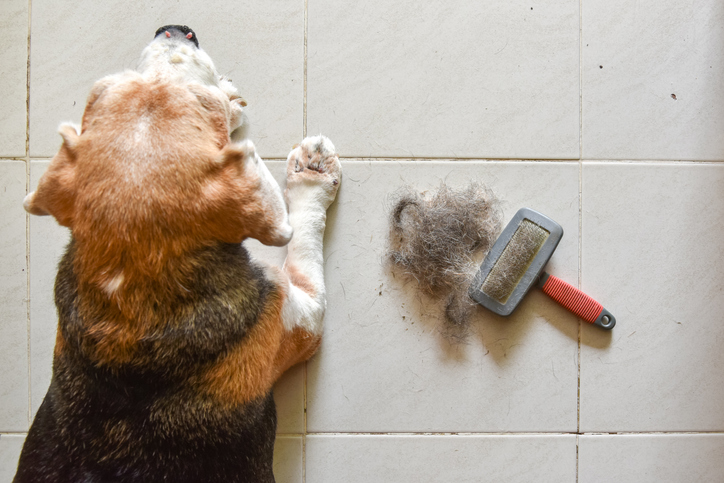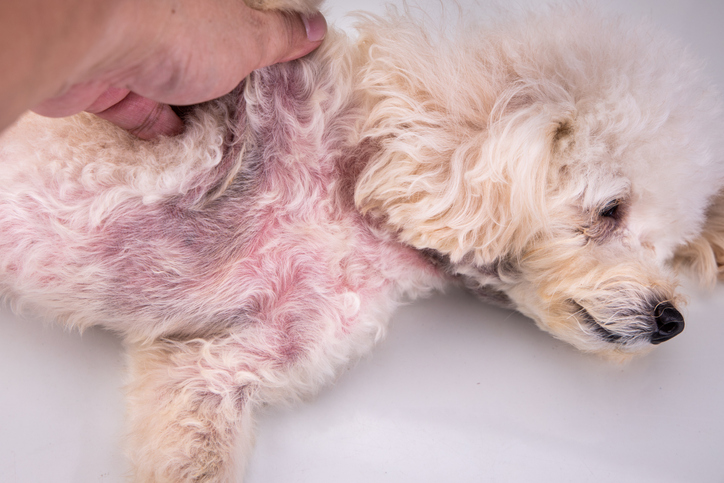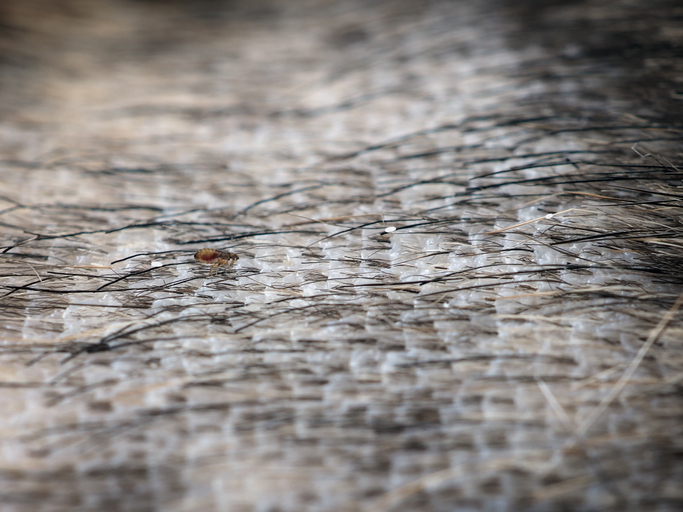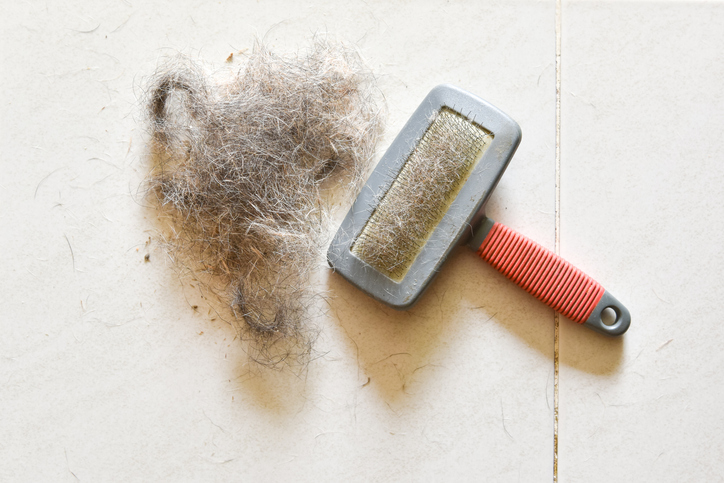Dog dandruff: Discover ways to help your pooch
Concerned about dog dandruff? Find out how to identify and treat the condition

Dog dandruff is easy to spot. It manifests itself as small white flakes which appear on your pooch's fur and you may also see them in other places such as on the sofa or bedding, and it might even persist despite using the best dog shampoo. Often you'll find dandruff coincides with increased scratching or irritated skin. But what is dog dandruff?
What you're actually seeing is dry, flaky skin consisting of dead cells that are getting caught in the fur and, in some cases, being transferred on to household items. But the good news is the condition can be treated. Just remember that dandruff can also be a sign of an underlying condition or illness so be sure to deal with it as soon as possible.
- Does dog shampoo expire? How to tell
- Homemade dog shampoos: the best DIY recipes
- Can you use baby shampoo on dogs?
What causes dog dandruff?

There are many reasons why dandruff develops. In humans, it's generally due to dry or irritated oily skin, conditions such as eczema and psoriasis, sensitivity to certain hair products or Malassezia – a yeast that grows in the hair follicles.
In dogs, the causes can be much the same and, in general, anything that leads to dry skin on dogs is generally to blame, as is anything which causes itching. You will find that dandruff is typically due to:
A poor diet. Dogs need a diet rich in nutrients in order to keep their skin and coat in a healthy condition. It's well known that insufficient healthy fats are problematic so make sure your dog has plenty of omega-3 essential fatty acids and is fed the best dog food.
A dry environment. Dandruff may be more prevalent during the winter when you have the central heating turned up, drying the skin. It can also be a problem among dogs living in warm countries. Regular grooming can help by redistributing natural oils over the skin.
Allergies and illness. Food and environmental allergies (such as dust or pollen) can cause scratching and dry skin. Some conditions including hypothyroidism and, rarely, autoimmune skin disease can also be the culprit. It's a good idea to visit a vet if you suspect either one.
Malassezia. Dogs can also suffer from Malassezia, primarily around the lips, ear canals, between the toes and facial skinfolds and on the neck and armpits. It leaves the skin looking red and sore, resulting in flakiness. Again, a trip to the vet is in order.
Seborrhea. This occurs when the sebaceous glands produce too little or too much sebum, which is a normal oily secretion of the skin. When there is not enough oil, the skin becomes dry and itchy. When there's too much, it's discomforting, so your dog is likely to scratch, removing tiny flakes of skin. Visit a vet.
Grooming. If your dog is over-grooming – or, indeed, if you are grooming your dog too much – then this can cause the skin to be stripped of its natural oils, causing it to become dry. If you suspect this could be the cause, groom less regularly or change the routine.
Dog dandruff or flea eggs?

Another major cause of dandruff are fleas and lice, primarily because they make the skin itchy. They also lay eggs on the skin so you may end up mistaking both the critters and the eggs as being dandruff rather than something that requires the best flea treatment for dogs.
One way to tell the difference is to look for the flakes' position and test whether they easily fall out by running a comb through. Lice, for example, lay eggs on the hair and cling on tight so if the specks fall out rather easily, then you're more likely to be dealing with dandruff.
Flea eggs are also thicker and distinguishable from dandruff. You'll notice eggs are of a similar shape and size whereas dandruff are far more irregular. They are sticky and usually accompanied by other telltale signs such as red flea bite marks on the skin.
Finally, watch out for cheyletiella mites. They don't cause dandruff but, again, they can be mistaken for it. Although these little blighters are only small – just 0.015 inches (0.383 millimetres) long – that just about makes them visible. They also live on the skin of dogs making closer observation necessary.
Now, some people actually call these eight-legged mites “walking dandruff” and that's actually a good way to tell the difference between them and dandruff: if the white flakes move then they're more likely to be mites. Dandruff can't walk!
Dog dandruff shampoo
For most instances of dandruff (that is, those which are not being caused by an underlying condition), you simply need to get hold of some dog shampoo for treating the condition.
Never use human dandruff shampoo because the ingredients could be harmful but instead look for those specially formulated for pooches and seek the advice of a vet if you believe the issue may be more serious such as treating fleas or seborrhea.
Many dog shampoos for dandruff contain salicylic acid which exfoliates skin as well as glycerin which retains moisture and this will greatly reduce those annoying flakes. But there are lots of other products, including natural shampoos on the market and many that haven't been tested on animals. If a dog dandruff shampoo is not working, however, it could be indicative of another underlying issue.
Other dog dandruff treatments

A good grooming routine can have a beneficial effect, not just in combating dandruff but the overall health of your dog's coat and skin. Perhaps consider these 10 great dog bath, grooming, and clean up products being careful not to brush too hard.
It's a good idea to learn how to give a dog a bath as well. Baths can help with outbreaks of seborrhea and they can also assist fungal and bacterial infections. Indeed, more frequent bathing is often recommended by vets as a way to keep the skin from drying out.
Other things to try are fatty acid supplements although a good dog food should contain plenty. You may want to look at ways of preventing your home from drying out. Our sister website, TechRadar recommends the Dyson Pure Humidify+Cool air purifier and humidifier.
PetsRadar Newsletter
Get the best advice, tips and top tech for your beloved Pets

David Crookes has been a journalist for almost 30 years and he has written for a host of magazines, newspapers, websites and books including the World of Animals Annual, BBC Earth, Live Science, The Independent and Tom’s Guide.
Born in England, he lives with two cats but he’s also keenly interested in the differences between the huge number of dog breeds – in fact, you can read many of his breed guides that he’s written in collaboration with vets here on PetsRadar.
With a lifelong passion for technology, too, he’s always on the lookout for useful devices that will allow people to keep their pets happier and healthier, and provide them more time to spend together.
David has a degree from Durham University, as well as postgraduate diploma in journalism from the University of Central Lancashire.
